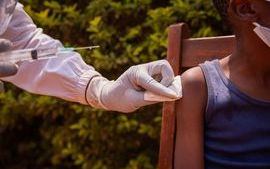- Published:
- 16 October 2025
- Author:
- Owain Donnelly
- Read time:
- 7 Mins
Despite significant control efforts since the turn of the millennium, globally there are still 263 million cases of malaria per year, with an annual total of approximately 600,000 deaths. Of these, 74% are in children under 5.1 New approaches to malaria control, complementing the use of insecticide-treated nets and current first-line therapies, are sorely needed to decrease this significant morbidity and mortality burden. This article reviews the status of malaria vaccination and other novel approaches to prevention and treatment.
Malaria, caused by protozoan parasites of the genus Plasmodium, remains a significant cause of morbidity and mortality globally. Most cases and deaths worldwide are caused by P. falciparum and approximately 95% of cases and deaths occur in Sub-Saharan Africa.
Current programmes to control malaria involve a number of approaches, including ensuring access to first-line artemisinin-based therapies for treatment, prophylaxis for key populations at risk and control of the vector – the female Anopheles mosquito. Prophylaxis may entail year-round mass drug administration, seasonal malaria chemoprophylaxis (SMC), or intermittent preventative therapy (IPT) for populations most at risk of severe disease, pregnant women (IPTp) or children under 5 (IPTi). Vector control has a number of dimensions, but most frequently includes distribution of insecticide-treated bed nets (ITNs) and indoor residual spraying (IRS) of insecticides.
Significant efforts since the early 2000s resulted in cases plateauing around 2015, but they have increased again since then, in part due to disruption caused by the COVID-19 pandemic.1 Other barriers to decreasing the morbidity and mortality caused by malaria include drug resistance (prevalent in South-East Asia and making inroads into Sub-Saharan Africa), failures of rapid diagnostic tests and vector resistance to insecticides. Given the significant steps that still need to be taken to bring about the eradication of malaria, new tools will need to be developed to significantly reduce this burden of cases.
A rapid way to reduce morbidity and mortality would be long-lasting protection with a malaria vaccine. However, until recently, many candidates that were promising in lab and animal studies did not lead to sufficiently robust protection from infection and/or severe disease. After several decades’ work on malaria vaccines, in 2021 the World Health Organization (WHO) recommended use of the RTS,S/AS01E vaccine, with the RTS,S antigen being a combination of malaria circumsporozoite protein (CSP), expressed by the human-infectious sporozoite stage of the parasite, and hepatitis B surface antigen (HBsAg).
Phase III studies had shown that, with a 4-dose vaccine schedule (0, 1, 2, and 20 months), the RTS,S vaccine reduced clinical malaria cases by approximately 36% over the 48 months from the first injection.2 A second vaccine containing the CSP antigen, R21/Matrix-M, was approved by WHO in 2023, having demonstrated a 75% drop in malaria cases when administered seasonally, or 68% when administered non-seasonally, after 3 doses (at 0, 1, and 2 months) in a Phase III trial.3
With both vaccines recommended for use in children in at-risk areas from the age of 5 months by the WHO, they have the potential to dramatically reduce malaria cases, especially when combined with other existing interventions, such as SMC. In a trial from Mali and Burkina Faso, the combination of RTS,S/AS01E reduced malaria incidence by 62.5%, hospitalisation with severe malaria by 70.5% and death from malaria by 72.9% compared with SMC alone.4
However, as with other vaccination campaigns, the logistics of delivering widespread vaccinations (especially if requiring a number of doses) in endemic areas are not straightforward. Funding for vaccination campaigns must be made available to achieve the maximum possible benefit.5 In view of the WHO recommendation, malaria vaccines are now included in the vaccination schedules of at least some regions of 17 African countries.6
While these vaccines target the infectious sporozoite stage to prevent parasite invasion of hepatocytes, which is the first stage of malaria infection, Phase I trials are also ongoing in other areas. These trials include exploring disease-attenuating vaccines targeting red blood cell invasion,7 high-risk malaria in pregnancy by targeting the placenta-binding protein VAR2CSA8 and transmission-blocking vaccines targeting the transmissible, sexually-recombining gametocyte stages of the parasite.9
An enticing possibility for transmission control is to use existing technologies, such as bed nets, but using antimalarial coatings that target the mosquito stages of Plasmodium rather than insecticides. Mosquito resistance to insecticides on nets is a significant concern; antimalarial coatings would avoid impact on the mosquito vector.
Recent preclinical work, testing novel inhibitors of cytochrome B of the parasite’s electron transport chain (the target of current antimalarial drug atovaquone) in mosquitos, found that combinations of 2 drugs (from a drug series currently designated ELQ, for endochin-like quinolones) implanted on bed net-like material significantly impeded or, in some cases, entirely ablated mosquito infection.10 This occurred whether the mosquito took up an infectious blood meal before or after contact with the net. The drug was absorbed sufficiently to achieve this, both when it was applied directly to the body of the mosquito and when the mosquito landed on the net and had only tarsal (i.e. leg) contact with the chemicals. While concerns about cross-resistance with atovaquone may exist, atovaquone-resistant parasites have been found to not infect mosquitos efficiently and, therefore, are likely less transmissible.11
Chloroquine resistance has become widespread globally in P. falciparum. Partial resistance to artemisinin derivatives, which form the backbone of first-line artemisinin-based combination therapies (ACTs), causes treatment failures and threatens the ability to use a standard 3-day treatment course for non-severe malaria. Alarmingly, while previously seen in South-East Asia, artemisinin resistance has now been identified in Eastern and Central Africa, which – given the number of cases there – could result in a public health catastrophe.12 Novel drugs with new mechanisms of action and without cross-resistance mechanisms are urgently needed to spread the balance of risk of significant, widespread drug resistance.
Fortunately, owing to concerted efforts spearheaded by the Medicines for Malaria Venture (a public–private partnership funded in large part by the Gates Foundation), 2 novel antimalarial drugs are nearing deployment: ganaplacide and cipargamin. As well as being efficacious against the disease-causing asexual blood stages of malaria, both drugs target the sexual stage gametocytes (unlike most currently used drugs), thereby affording an opportunity to block onward transmission and reduce cases.
Ganaplacide targets the liver stages of malaria,13 as well as asexual blood stages and gametocytes. Paired with lumefantrine, it showed promise as a non-ACT combination treatment of non-severe malaria in a Phase II trial.14 Cipargamin is notable for killing parasites rapidly, faster even than artemisinins. However, in a Phase II study for uncomplicated malaria, a significant rate of recrudescent, drug-resistant parasites was found with cipargamin monotherapy.15 Use of an adequate partner drug could overcome this limitation, and the rapid kill-rate could be a significant asset in improving malaria outcomes. It is now being explored in other trials with such partner drugs. Given cipargamin’s potency, an ongoing trial is also assessing its efficacy as a standalone first-line intravenous therapy for severe malaria, as an alternative to intravenous artesunate, the currently recommended first-line drug.16
Together, these drugs may widen the available therapeutics for malaria treatment, offering a number of choices in the face of increasing drug resistance. Given their efficacy against sexual stages, they may also reduce onward transmission in endemic settings, further reducing cases.
As well as novel drugs, the repurposing of existing drugs in new combinations and formulations is being explored for improved malaria treatment and control. Recently, a specific formulation of the ACT artemether-lumefantrine designed to take into account the specific pharmacokinetics and pharmacodynamics needs of babies was approved, when previously weight-based dosing extrapolated from older children was used, increasing the risk of toxicity.
While the picture for malaria globally is challenging, especially in view of recent global health funding cuts,17 novel control methods offer cause for hope. Adequate funding, political will and stakeholder buy-in on implementation, alongside existing anti-malaria interventions, may enable significant progress in the malaria landscape.
References available on our website.




